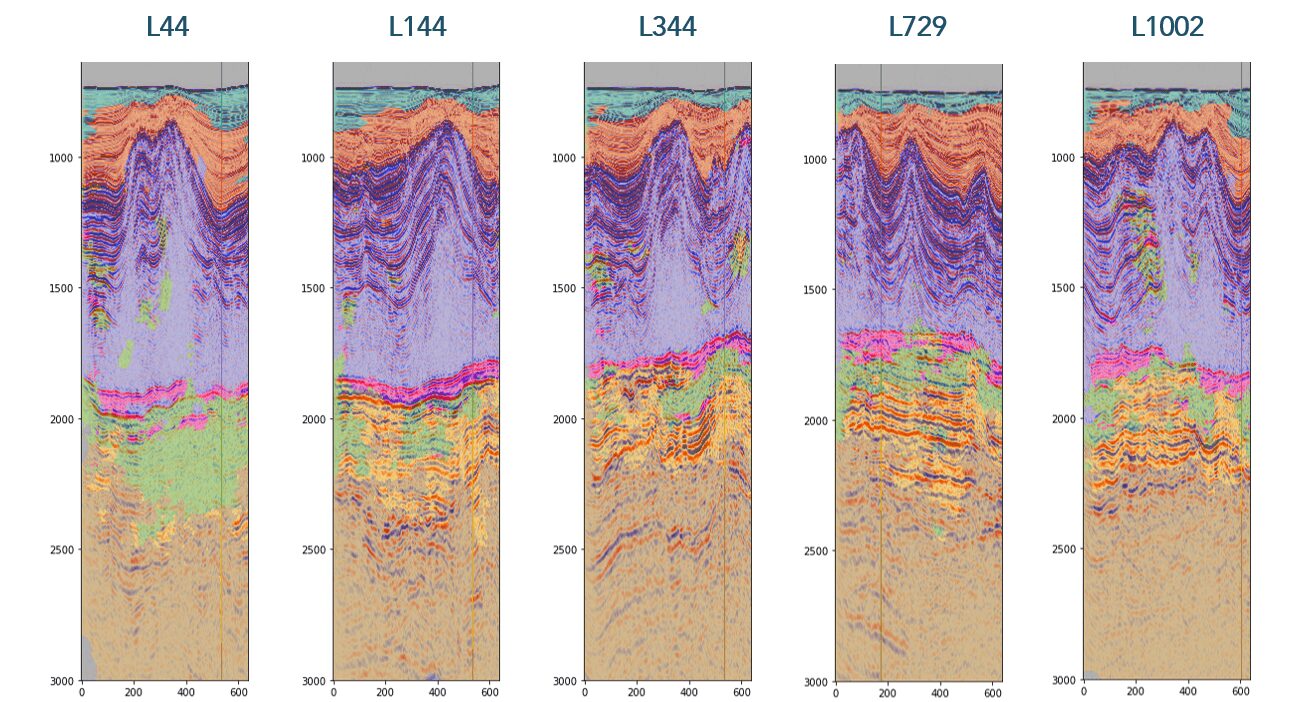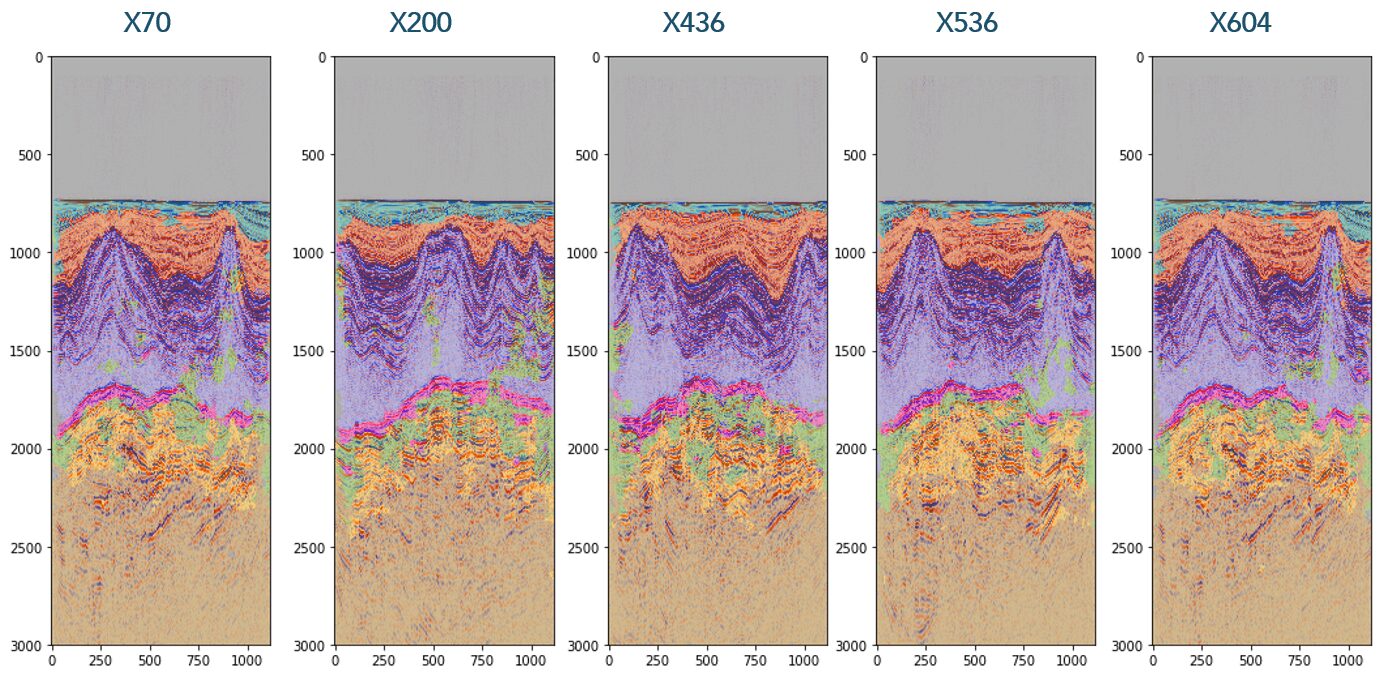3D Seismic Interpretation Augmented by Bluware Deep Learning with Immediate Results in Brazil Santos and Gulf of Mexico Basins
Challenge
When working with stacked datasets, the data is smeared and subtle variations cannot be detected.
Input
Processed and migrated seismic gathers and equivalent seismic velocities were used in this example.
Method
This method accommodates for 4D, wide-azimuth (WAZ) and full-azimuth (FAZ) seismic data.
-
Load all gathers with and/or without normal moveout (NMO). If gathers are not normal, move out is corrected and velocities can be loaded and interactively manipulated to be used on NMO correction.
-
If needed, gathers can be conditioned.
-
Create partial and/or full 3D-stacks on the fly, according to the geologic problem and objectives of the project.
-
Using the chosen stacks, use Bluware InteractivAI Deep Learning for the interpretation of faults, salt, channels, and gas chimneys. Interpretation of facies will be a future capability.
The results are significantly faster with Bluware InteractivAI Deep Learning because:
-
There is no need to prepare the data for deep learning by slicing and randomizing images.
-
There is no need to quality control (QC) and edit the results as the seismic interpreter is interactively training and conducting QC on the results in real-time.
The results are more reliable with Bluware InteractivAI Deep Learning because:
-
All the seismic data is mapped and there are no interpolations.
-
The interpreter has the freedom to incorporate the preferred geological model for the area obtained from different scale datasets (core, outcrop, thin sections, etc.).
-
All the information contained in the seismic data is used, not just the limited post-stack data set.
Case Study: Bluware DEEP LEARNING Applied to Regions with Massive Evaporite Sequences
Brazil Santos Basin
Challenge
Companies are required by the national government to monitor oil field production for the entire life of the field. Large reserves of oil are found in carbonate reservoirs located below a massive sequence of evaporites that contain a diverse mineralogical composition, which makes illumination challenging and effects the frequency band of the seismic data.
To monitor changes in time in the reservoir, time-lapse 4D surveys are acquired. Nodes are the preferred methodology because the existing production infrastructure makes streamer acquisition challenging. Plus it is crucial to be precise on the repeat locations. The combination of the node acquisition, which by nature is FAZ, with the repetition of time-lapse 4D surveys, produces very large data volumes. This leads to operational challenges, as data needs to be loaded, visualized, processed, and interpreted in a timely manner to avoid increased project costs. These volumes are multiplied through time as more data is acquired over a field’s 4D node surveys.

Current Traditional Workflow
Interpretation begins on stacked data, so interpreters loose almost 90% of the crucial information present in pre-stacked data. Stacked data has subtle amplitude variations that can easily be missed. Additionally, variation of amplitude with offsets will not be detected. Before a geoscientist even starts their interpretation, the data already contains bias from the velocity model.
Stacked datasets are often created by external vendors with little input from the final user. Companies are charged for any additional partial stack, and those partial stacks are created on pre-set angles and offsets without a high level of QC. Crucial time can be lost waiting for 3D partial stacks from a vendor. If a dataset is too large for the interpretation software, the user can decimate the data and/or subset the area in smaller sub-volumes.
Bluware Deep Learning Workflow
With the unique ability to work directly with unlimited pre-stacked data, Bluware enables the interpreter to interactively visualize and stack in real-time to create ideal angles of illumination of the subsurface. The user can stack the dataset interactively and create volumes at the click of a button. Multiple volumes can then be interpreted using the Bluware DEEP LEARNING interpretation tool.


Gulf of Mexico Basin
Challenge
Large volumes of allochthonous salt have moved and pierced through large sedimentary sequences. Halokinetics caused significant deformation and created one of the more structurally complex areas on Earth. Hundreds of mini basins formed due to salt evacuation. Steep rock beds, areas of over pressure, and stress rotation around salt domes are common. Imaging around and below the salt is a challenge, but necessary to understand trap, trap size risk, migration pathways, source rock maturity, and change among other petroleum system elements.
Current Traditional Workflow
Interpretation begins on stacked data, so interpreters loose almost 90% of the crucial information present in pre-stacked data. Stacked data has subtle amplitude variations that can easily be missed. Additionally, variation of amplitude with offsets will not be detected. Before a geoscientist even starts their interpretation, the data already contains bias from the velocity model.
Stacked datasets are often created by external vendors with little input from the final user. Companies are charged for any additional partial stack, and those partial stacks are created on pre-set angles and offsets without a high level of QC. Crucial time can be lost waiting for 3D partial stacks from a vendor. If a dataset is too large for the interpretation software, the user can decimate the data and/or subset the area in smaller sub-volumes.
Bluware Deep Learning Workflow
The combination of anisotropy, high deformation, and velocity variations can make size estimation a challenge. Bluware’s velocity modeling, combined with on-the-fly stacking functionality, allows the interpreter to easily create multiple case scenarios. Since the velocity data can be adjusted on-the-fly, different velocities can be used to create multiple 3D stacks. Variable azimuths are often used for proper illumination below salt. Bluware WAZ on-the-fly stacking functionality can help the interpreter create more fit-for-purpose stacks. Working with multiple hypotheses makes it possible to have a distribution of trap risks and sizes. Manually interpreting multiple volumes is a challenge, but now with Bluware DEEP LEARNING the interpretation process can be accelerated 20 to 30 times allowing for time to interpret multiple seismic volumes.
Amplitude variation with offset (AVO) plays are common in the region, most of those are already being drilled in the United States, but remain to be drilled in the Mexican portion of the Gulf of Mexico. Bluware’s pre-stack functionality is particularly powerful to work on these amplitude plays. Partial stacks, gather conditioning, and AVO on-the-fly can help accelerate identification of these prospects.
